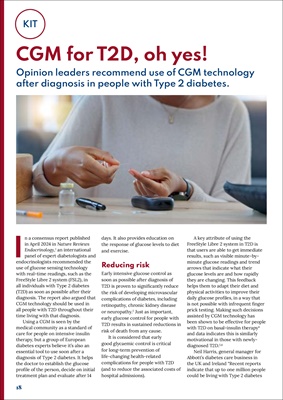
18KIT
CGM for T2D, oh yes!
Opinion leaders recommend use of CGM technology
after diagnosis in people with Type 2 diabetes.
In a consensus report published
in April 2024 in Nature Reviews
Endocrinology,1 an international
panel of expert diabetologists and
endocrinologists recommended the
use of glucose sensing technology
with real-time readings, such as the
FreeStyle Libre 2 system (FSL2), in
all individuals with Type 2 diabetes
(T2D) as soon as possible after their
diagnosis. The report also argued that
CGM technology should be used in
all people with T2D throughout their
time living with that diagnosis.
Using a CGM is seen by the
medical community as a standard of
care for people on intensive insulin
therapy, but a group of European
diabetes experts believe it's also an
essential tool to use soon after a
diagnosis of Type 2 diabetes. It helps
the doctor to establish the glucose
profile of the person, decide on initial
treatment plan and evaluate after 14
days. It also provides education on
the response of glucose levels to diet
and exercise.
Reducing risk
Early intensive glucose control as
soon as possible after diagnosis of
T2D is proven to significantly reduce
the risk of developing microvascular
complications of diabetes, including
retinopathy, chronic kidney disease
or neuropathy.2 Just as important,
early glucose control for people with
T2D results in sustained reductions in
risk of death from any cause.
It is considered that early
good glycaemic control is critical
for long-term prevention of
life-changing health-related
complications for people with T2D
(and to reduce the associated costs of
hospital admissions).
A key attribute of using the
FreeStyle Libre 2 system in T2D is
that users are able to get immediate
results, such as visible minute-byminute glucose
readings and trend
arrows that indicate what their
glucose levels are and how rapidly
they are changing. This feedback
helps them to adapt their diet and
physical activities to improve their
daily glucose profiles, in a way that
is not possible with infrequent finger
prick testing. Making such decisions
assisted by CGM technology has
been shown to be effective for people
with T2D on basal-insulin therapy4
and data indicates this is similarly
motivational in those with newlydiagnosed
T2D.5,6
Neil Harris, general manager for
Abbott's diabetes care business in
the UK and Ireland "Recent reports
indicate that up to one million people
could be living with Type 2 diabetes